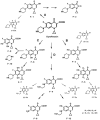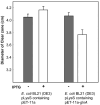Unusual and Unconsidered Mechanisms of Bacterial Resilience and Resistance to Quinolones
- PMID: 38541707
- PMCID: PMC10971285
- DOI: 10.3390/life14030383
Unusual and Unconsidered Mechanisms of Bacterial Resilience and Resistance to Quinolones
Abstract
Quinolone resistance has been largely related to the presence of specific point mutations in chromosomal targets, with an accessory role of impaired uptake and enhanced pump-out. Meanwhile the relevance of transferable mechanisms of resistance able to protect the target of pump-out or inactivate quinolones has been increasingly reported since 1998. Nevertheless, bacteria have other strategies and mechanisms allowing them to survive and even proliferate in the presence of quinolones, which might be qualified as resistance or resilience mechanisms. These include decreasing levels of quinolone target production, transient amoeba protection, benthonic lifestyle, nutrient-independent slow growth, activation of stringent response, inactivation or degradation of quinolones as well as apparently unrelated or forgotten chromosomal mutations. These mechanisms have been largely overlooked, either because of the use of classical approaches to antibiotic resistance determination or due to the low increase in final minimum inhibitory concentration levels. This article is devoted to a review of a series of these mechanisms.
Keywords: RNA polymerase mutation; amoeba; biofilm; quinolone targets; quinolones inactivation; stringent response; toxin/antitoxin systems.
Conflict of interest statement
The authors declare no conflicts of interest.
Figures





Similar articles
-
Transferable mechanisms of quinolone resistance.Int J Antimicrob Agents. 2012 Sep;40(3):196-203. doi: 10.1016/j.ijantimicag.2012.02.011. Epub 2012 Jul 23. Int J Antimicrob Agents. 2012. PMID: 22831841 Review.
-
Prevalence of quinolone resistance mechanisms and associations to minimum inhibitory concentrations in quinolone-resistant Escherichia coli isolated from humans and swine in Denmark.Microb Drug Resist. 2008 Jun;14(2):163-9. doi: 10.1089/mdr.2008.0821. Microb Drug Resist. 2008. PMID: 18500921
-
Mechanism of plasmid-mediated quinolone resistance.Proc Natl Acad Sci U S A. 2002 Apr 16;99(8):5638-42. doi: 10.1073/pnas.082092899. Epub 2002 Apr 9. Proc Natl Acad Sci U S A. 2002. PMID: 11943863 Free PMC article.
-
Mechanism of action of and resistance to quinolones.Microb Biotechnol. 2009 Jan;2(1):40-61. doi: 10.1111/j.1751-7915.2008.00063.x. Epub 2008 Oct 13. Microb Biotechnol. 2009. PMID: 21261881 Free PMC article. Review.
-
Mechanism of quinolone action and resistance.Biochemistry. 2014 Mar 18;53(10):1565-74. doi: 10.1021/bi5000564. Epub 2014 Mar 7. Biochemistry. 2014. PMID: 24576155 Free PMC article. Review.
Cited by
-
Antimicrobial susceptibility profiles of commensal Clostridium perfringens isolates from chickens in Hungarian poultry farms between 2022 and 2023.Front Vet Sci. 2025 Jul 25;12:1589747. doi: 10.3389/fvets.2025.1589747. eCollection 2025. Front Vet Sci. 2025. PMID: 40786975 Free PMC article.
References
-
- Barton N., Crowther A.F., Hepworth W., Richardson N.D., Driver G.W. New Quinolones and Therapeutic Compositions Containing Them. 830832. British Patent. 1960 March 23;
Publication types
Grants and funding
LinkOut - more resources
Full Text Sources

